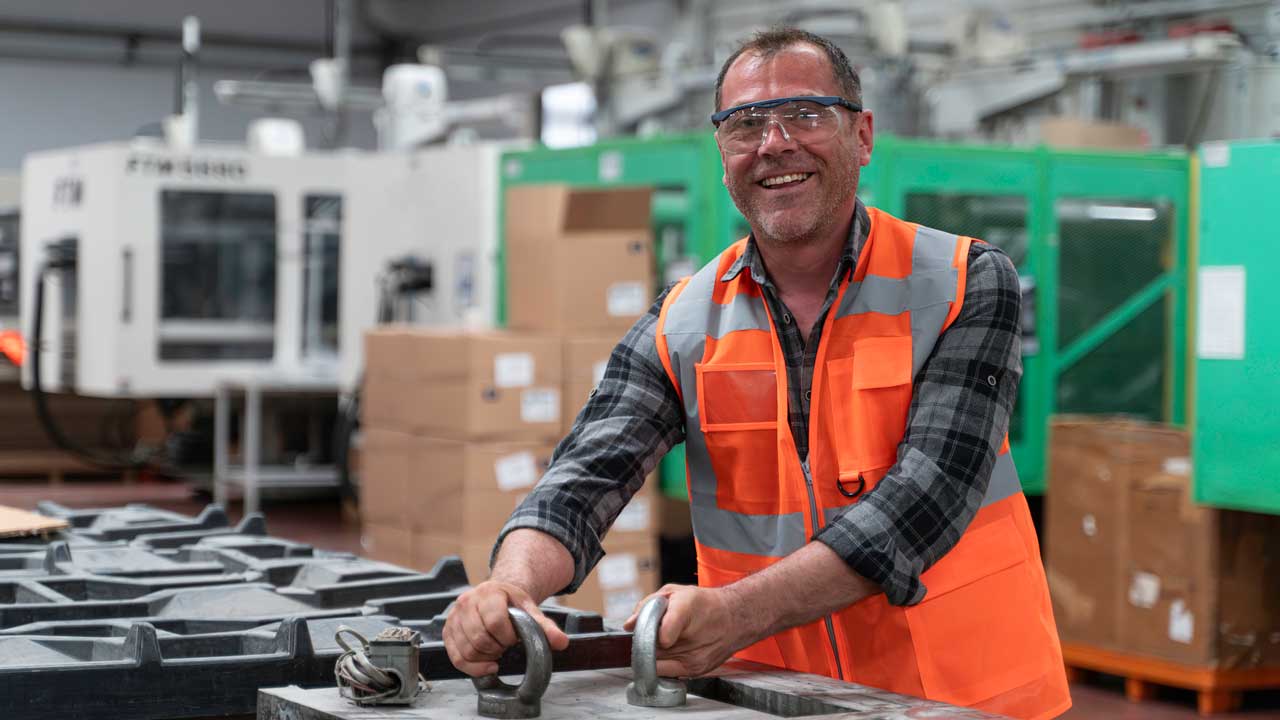New Technologies that Make Barrel Lifting Safer and More Efficient
Key Takeaways
- Precision Tilt and Rotation Controls Enable Optimal Positioning Infinite positioning control and variable speed rotation eliminate manual wrestling with heavy containers while maintaining precise control.
- Load Sensing Technology Prevents Overload and Equipment Damage Real-time monitoring of container weight, content distribution, and dynamic loading.
- Automated Handling Reduces Cycle Times and Improves Accuracy Optimized movement patterns increase throughput capacity while ensuring consistent results.
- Custom Solutions Address Industry-Specific Requirements Chemical processing, pharmaceutical, food and beverage, and oil and lubricant facilities benefit from our equipment.
Barrel lifting equipment has undergone revolutionary technological advancement in recent years, transforming one of manufacturing’s most hazardous material handling operations into a precise, safe, and efficient process. At Ergotronix, we’ve pioneered innovations that address the unique challenges of cylindrical container handling, from lightweight chemical drums to massive industrial barrels weighing thousands of pounds. We’ve engineered our specialized lifting solutions to address the complex dynamics of barrel manipulation while providing the reliability that critical operations require.
Today’s barrel lifting equipment integrates advanced sensing, automated controls, and intelligent safety systems, transforming dangerous manual operations into controlled, predictable processes that protect workers while optimizing throughput and accuracy.
Challenges in Traditional Barrel Handling Operations
Traditional barrel handling methods create numerous hazards that modern technology can effectively eliminate. The cylindrical shape of barrels makes them inherently unstable during lifting and transport, requiring workers to maintain awkward grips while managing shifting loads that can suddenly change balance characteristics.
Manual barrel lifting forces workers into compromised postures, with extended reaches, twisted spines, and asymmetric loading, creating a high injury risk even with proper lifting techniques. The weight distribution of filled barrels concentrates stress on specific body segments, often exceeding safe biomechanical limits, regardless of worker strength or experience.
Liquid-filled barrels present additional challenges through dynamic loading that changes during movement. Sloshing liquids create momentum shifts that can overwhelm worker control, leading to dropped containers, spills, and potential injury from sudden load changes.
Surface conditions on barrels often compromise grip security, whether from moisture, chemical residues, or smooth finishes that provide inadequate friction for reliable manual handling. These grip challenges increase the force requirements for safe handling while reducing worker confidence and control.
The repetitive nature of barrel handling operations compounds individual lift hazards through cumulative stress that builds throughout shifts. Workers may handle dozens of barrels daily, creating cumulative exposure that can cause injury even when individual lifts remain within apparent safe limits.
Innovative Features in Modern Barrel Lifting Equipment
Automated Gripping Systems
Automated gripping technology revolutionizes barrel lifting equipment by eliminating manual contact with barrel surfaces while providing secure, consistent engagement regardless of barrel condition or surface characteristics. Our custom lifting equipment features gripping systems that automatically adjust to various barrel sizes and shapes, eliminating the need for manual setup or adjustment.
Advanced gripping mechanisms utilize multiple contact points that distribute gripping forces evenly around barrel circumferences, preventing deformation while ensuring secure engagement. These systems can accommodate variations in barrel dimensions, surface conditions, and material characteristics without compromising grip security.
Pressure monitoring within automated gripping systems provides real-time feedback on grip force and barrel integrity, preventing over-compression that could damage containers while ensuring adequate holding force for safe manipulation. This monitoring capability is particularly valuable when handling delicate or thin-walled containers.
Safety interlocks prevent lifting operations when gripping systems haven’t achieved proper engagement, eliminating the possibility of dropped barrels due to inadequate grip. These interlocks provide multiple redundancy levels, ensuring reliable operation even in the event of component failures.
Tilt and Rotation Controls
Precision tilt and rotation capabilities enable barrel lifting equipment to position containers at optimal angles for filling, emptying, and processing operations, eliminating the need for manual repositioning and reducing worker exposure to awkward positions. Our systems offer infinite positioning control, accommodating any required angle or orientation.
Controlled rotation enables gradual mixing operations for settled materials while preventing the violent agitation that can cause container damage or content spillage. Variable speed rotation allows optimization for different materials and processing requirements.
Synchronized tilt and rotation movements enable complex positioning sequences that position barrels optimally for automated processing equipment while maintaining precise control over content distribution and flow characteristics.
The combination of tilt and rotation capabilities eliminates the manual wrestling with heavy containers that traditionally characterized barrel positioning operations, reducing physical demands while improving positioning accuracy and consistency.
Load Sensing Technology
Intelligent load sensing transforms barrel lifting equipment operation by providing real-time information about container weight, content distribution, and dynamic loading characteristics, enabling optimal handling strategies. Advanced sensors monitor not only total weight but also weight distribution and changes in center of gravity during handling.
Dynamic load monitoring detects liquid movement within containers, enabling handling strategies that minimize sloshing while predicting momentum changes that could affect stability. This monitoring capability is crucial for maintaining control during transport and positioning operations.
Overload protection systems automatically adjust lifting parameters or halt operations when safe load limits are approached, preventing equipment damage while protecting both operators and containers from excessive forces.
Load-sensing integration with control systems enables the automatic optimization of lifting speeds, acceleration rates, and positioning movements based on actual container characteristics, rather than preset parameters.
Safety Enhancements in Barrel Handling
Modern barrel lifting equipment incorporates comprehensive safety systems that address the multiple hazards associated with barrel handling operations:
- Containment systems preventing spills and exposure during container handling through integrated drip trays and vapor containment features
- Emergency release mechanisms enabling immediate barrel release during emergency situations while maintaining operator safety and preventing equipment damage
- Operator isolation barriers protecting workers from container movement zones while maintaining necessary access for monitoring and control
- Environmental monitoring detecting hazardous vapors or spill conditions that require immediate response and evacuation procedures
- Fail-safe gripping maintaining secure container engagement even during power failures or component malfunctions through mechanical locking systems
- Motion limiting, restricting equipment movement to safe zones and preventing collisions with facility structures or other equipment
- Visual and audible alarms providing clear indication of operational status, safety conditions, and required operator actions
Operational Efficiency Improvements
Barrel lifting equipment technology delivers substantial efficiency gains through multiple operational enhancements:
- Reduced handling time through automated gripping and positioning that eliminates manual setup and adjustment requirements for each container
- Improved positioning accuracy enabling precise placement for automated filling, processing, and packaging operations without manual fine-tuning
- Enhanced throughput capacity supporting higher container processing rates through optimized movement patterns and reduced cycle times
- Minimized product loss through controlled handling that prevents spills, damage, and waste associated with manual handling methods
- Consistent operation quality, eliminating human variability in handling techniques that can affect processing outcomes and product quality
- Reduced secondary handling through integrated transport and positioning capabilities that eliminate intermediate handling steps
- Optimized workflow integration, coordinating with other production equipment to minimize bottlenecks and maximize overall line efficiency
Industry Applications for Advanced Barrel Lifters
Barrel lifting equipment serves diverse industries with specialized requirements for safe, efficient container handling. Chemical processing facilities benefit from automated systems that minimize operator exposure to hazardous materials while ensuring proper container positioning for filling and emptying operations.
Food and beverage operations utilize barrel handling technology for ingredient storage, processing, and packaging applications, where contamination prevention and precise positioning are crucial for maintaining product quality and ensuring regulatory compliance.
Pharmaceutical manufacturing relies on advanced barrel handling for active ingredient processing, where precise positioning and contamination control are essential for product safety and regulatory compliance. Our material transport systems provide the precision and cleanliness required for pharmaceutical applications.
Oil and lubricant facilities require robust barrel handling systems that can manage heavy containers while preventing environmental contamination through spill prevention and containment features. Our portable material handling expertise ensures your investment delivers maximum value while supporting your ergonomic workplace solutions goals.
Selection Guidelines for Barrel Lifting Systems
Choosing appropriate barrel lifting equipment requires evaluation of specific operational requirements and environmental conditions:
- Container specifications, including size ranges, weight capacities, and material characteristics that the system must accommodate safely and efficiently
- Environmental conditions addressing temperature ranges, chemical exposure, wash-down requirements, and explosion-proof classifications as needed
- Integration requirements ensuring compatibility with existing production equipment, facility layouts, and automation systems for seamless operation
- Throughput demands matching system capacity and cycle times to production requirements, while providing adequate capacity for peak demand periods
- Safety classifications meeting industry-specific safety standards and regulatory requirements for hazardous material handling applications
- Maintenance accessibility, ensuring all service points are easily reached and maintenance procedures can be performed safely and efficiently
Training and Efficiency Protocols
Successful barrel lifting equipment implementation requires comprehensive training programs that address both operational procedures and safety requirements:
- Equipment operation training covering all control functions, safety systems, and normal operating procedures for efficient, safe equipment use
- Emergency response procedures ensuring operators understand proper responses to equipment malfunctions, spills, or other emergency situations
- Maintenance awareness teaching operators to recognize signs of wear, damage, or malfunction that require immediate attention or service
- Quality assurance procedures establishing protocols for verifying proper container engagement, positioning accuracy, and operational safety before proceeding
- Efficiency optimization training operators to maximize throughput while maintaining safety standards through proper sequencing and coordination
- Documentation requirements ensuring proper record-keeping for regulatory compliance and performance tracking purposes
Get Your Expert Barrel Lifting Equipment Consultation Today
Revolutionary barrel lifting equipment technology offers unprecedented opportunities to enhance both safety and efficiency in container handling operations. Our positioning and handling equipment demonstrates how technological innovation creates value across all aspects of barrel handling operations. Our complete handling solutions provide the foundation for sustainable barrel handling operations that protect workers while meeting demanding production requirements.
Contact us today to discover how innovative barrel lifting equipment can augment your container handling operations while delivering measurable improvements in safety, efficiency, and operational performance.



